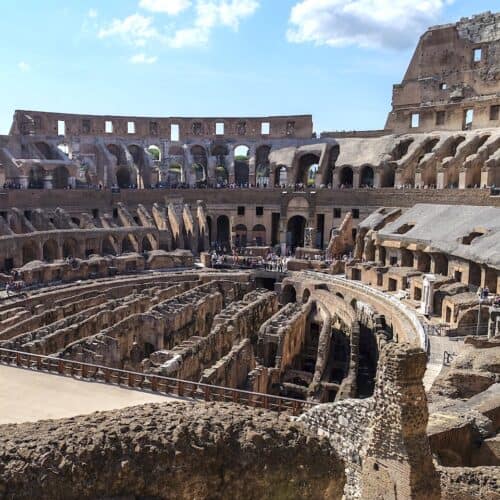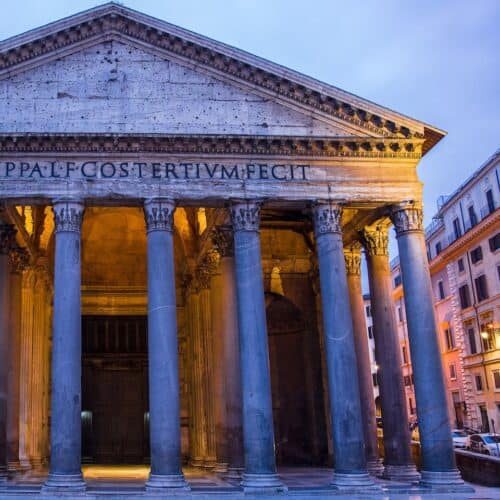The Must-Visit Attractions in Rome
Colosseum
In its prime, the Colosseum was home to several public events from gladiator contests to battle re-enactments, so it is accustomed to being full of spectators. When visiting the Colosseum, you are given the rare opportunity to step back in time to explore and analyze an ancient Roman ruin that dates back to 70 B.C.E. Amazingly so, the Colosseum remains relatively intact making the experience even more impressive.
Palatine Hill & Roman Forum
If you are only in Rome for a short period, you have to check out the highest hill in the city, the Palatine Hill. From that point, you can get a full view of the Rome cityscape and admire the lush gardens that encompass this looming hill. While at the top you can also see the Roman Forum. Visiting the Roman Forum is a must since it was once the home of some of Rome’s most important government buildings. There you can see what the daily life of Roman citizens was like in the most vivid way possible.
Ara Pacis
The Ara Pacis was a sacrificial altar dedicated to the victories of Emperor Augustus in Hispania and Gaul. It was built between 13 B.C.E. and 9 B.C.E. along the Tiber River where it eventually flooding in silt for over a millennium. Now, it has been restored and moved to its own museum. Once inside, guests can view not only the Tiber River but also the Mausoleum of Augustus where Augustus himself and much of his family was buried.
Galleria Borghese
Galleria Borghese is located in the Villa Borghese gardens and it once housed the private collection of Cardinal Scipione Borghese, the Pope’s personal secretary and a patron of Caravaggio and Bernini. In the galleria, you will witness one of the most exquisitely curated collections of sculptures, paintings, and antiques. Some of these masterpieces include Bernini’s David and Apollo and Daphne and Caravaggio’s Boy with a Basket of Fruit and David with the Head of Goliath.
-
Borghese Gallery Guided Tour
Original price was: €95,00.€76,00Current price is: €76,00.Book onlineQuick View -
Villa Borghese
This park is the largest park in central Rome and no matter where you walk in it you will always find some local musician serenading the visitors. If you’re waiting for your block to enter the Galleria Borghese, visiting the zoo, or just want a break from the hustle and bustle of the city, get out to the villa and explore all the natural Italian beauty that it has to offer. From various sculptures, reflective waters, and lush greenery, you will not get tired of exploring this villa.
Campidoglio and Musei Capitolini
Campidoglio or Capitoline Hill is one of the most important hills in Rome because it was created as symbol for Rome’s political and religious importance. The trapezoidal Piazza del Campidoglio was designed by Michelangelo in 1536. Even though he died before he got to see his design in fruition, builders followed Michelangelo’s plans meticulously so that it would remain true to his vision. At the piazza, you can see the Musei Capitolini, the world’s oldest public museum, which houses a multitude of ancient Roman statues, inscriptions, and other artefacts.
Castel Sant’Angelo
This castle has faced many changes since it was built in 139 CE. From its original owner the Emperor Hadrian, to its symbol of protection during the plague, and its use for refuge by Pope Clement in 1527, the castle has evolved with the Eternal City for many decades. Nowadays, the castle is used as a museum equipped with eloquent frescos, great views of the city, an extensive collection of weapons, and even prison cells.
Pantheon
The Pantheon is still one of the biggest mysteries of Rome. The structure itself is one of the best-preserved monuments of ancient Rome and it was completed during the reign of Emperor Hadrian in 127 C.E. Although many believe that the building was originally designed as a temple for Roman gods, there is no concrete documentation of what it was really used for. In fact, some believe that it was a hall designed for public appearances of the emperor.
Giardino degli Aranci
The Orange Garden, also known as the Parco Savello, is one of the most romantic spots in the Eternal City. Owned originally by the Savelli family in 1200 C.E., the garden contains the remains of a medieval wall that was part of the family’s ancient fortress. At this garden scented by the sweet smell of citrus, you can get a spectacular view of the Roman skyline over the Tiber River. The view from here is the ideal spot to grab a view of the Dome of St. Peter’s Basilica as well as a bacio.
Piazza Navona
This piazza was built on the site of the Stadium of Domitian (Circus Agonalis) where people would once go to see a variety of athletic competitions. At the piazza, you will find three beautiful fountains decorated with sculptures. Fontana dei Quattro Fiumi is in the center of the piazza and was designed by Bernini; the statues of the fountain are meant to represent the most important rivers of the spread of Christianity: the Nile, Danube, Ganges, and Rio de la Plata. Fontana del Moro is on the south of the piazza and was called the “Seashell Fountain;” Giacomo della Porta designed it but Bernini later finished it. Lastly, there is Fontana del Nettuno (Fountain of Neptune), it was also designed by Giacomo della Porta but it was finished by Antonio Della Bitta and Gregorio Zappala 300 years later.
Piazza di Spagna
One of the most famous piazzas of Rome is Piazza di Spagna, given its name because it houses Palazzo di Spagna, the seat of the Spanish Embassy for the Vatican. The piazza is also near the high streets of Via dei Condotti, Via Frattina, and Via del Babuino where you view 17th and 18th century villas and find a variety of high-end and budget shops. At the base of the steps there’s the Fontana della Barcaccia which was designed by Pietro Bernini, Gian Lorenzo Bernini’s father, and is decorated with emblems of the Barberini family. If you climb up the stairs, you can get a great view of the cityscape and see the Church of Trinita dei Monti.
Fontana di Trevi
The Trevi Fountain is by far one of the most popular fountains in the world and the largest Baroque fountain in all of Rome, designed by Nicola Salvi and completed by Pietro Bracci. Legend says that when you throw a coin into the Trevi Fountain, making sure to keep your back to it and throwing the coin with your right hand over your left shoulder, then you are guaranteed to return to Rome. Thanks to some restorations in 2014, the Trevi Fountain is just as magnificent at day or night.
Piazza San Pietro
St. Peter’s Square is the key-shaped piazza located right in front of St. Peter’s Basilica in Vatican City. It was commissioned by Pope Alexander XII between 1656 and 1667 and was designed by Bernini. In the piazza, you are surrounded by 284 columns and 140 statues of saints as well as two beautiful fountains and an obelisk. The piazza leads you straight to the largest Catholic Church, Saint Peter’s Basilica, where you can also find several works of art like St. Peter’s Baldachin, the Pietà, and St. Peter on his throne.
Vatican Museums
The Vatican museums are home to some of the most globally acclaimed masterpieces of sculptures, paintings, frescos, and other art pieces that have been collected by popes over the centuries. Some of the most well-known and exceptional works are the Sistine Chapel, the Chapel of Beato Angelico, the Raphael Rooms, the Borgia Apartments, and Loggia.
Monument of Victor Emanuel II (Vittoriano)
At the center of one of Rome’s central piazzas, Piazza Venezia, sits the Monument of Victor Emmanuel II (Vittoriano). The monument is the burial site of the unknown soldier and in the front of the building you will find the eternal flame which is guarded 24/7. Inside the monument is the Institute for the History of the Italian Risorgimento and the Central Museum of the Risorgimento. The Monument is one of the most breathtaking and eye-catching buildings in all of Rome.
Santa Maria Maggiore
The ancient Catholic Basilica of Santa Maria Maggiore is believed to be one of the largest churches in Rome in honor of the Virgin Mary. Originally the grounds for a pagan temple for the goddess Cybele, the now Catholic Basilica is one of the four major basilicas in Rome. Legend has it that the Virgin Mary appeared to Pope Liberius during the fourth century and told him how to build the church. Some of the different names the basilica has gone by are: Saint Mary of the Snow, Santa Maria Liberiana, St. Mary of the Nativity.
Palazzo Valentini – Domus Romane
Domus Romane is an underground museum under the Palazzo Valentini. In this multimedia display, you can experience the remains of the patrician “Domus” which belonged to powerful families of imperial Rome. With the addition of lights, sound effects, and projections of walls, rooms, peristyle, decorations, kitchens, furniture, and more, you will really feel like you are there in the 1500s.
Campo de’Fiori
Known as Field of Flowers, this piazza is promised to remain busy all day long. With its flower, fruit, and vegetable market during the day and lively bars, restaurants, and terraces at night, this piazza will never stop a beat. In the center of the piazza is a statue in honor of Giordano Bruno, an Italian philosopher who was burned at the stake for heresy in 1600.
Catacombs and Underground Rome
Underneath Rome is a part of the city just as ancient as all the treasures above ground. Rome is known for its popular catacombs and crypts which house thousands of remains, whether that be of monks or saints. These people were buried in these underground cemeteries to accommodate for the lack of space and price of land in Rome. When exploring underground Rome, you will find baths, villas, and even temples.
Terme di Caracalla
The Emperor Caracalla’s bathhouse was an essential part of life for ancient Romans and still remains as one of the most breathtaking ruins in Rome. In its prime it was home to baths, gyms, libraries, shops, and gardens and held upwards of 5000 people a day. Romans would attend the baths for both hygiene and socializing. The bathhouse was active from 214 C.E. until 537 C.E., when the aqueducts that provided water to the baths were destroyed by the Visigoths. The site today is also home to some amazing operas and ballets over the summer.
















































